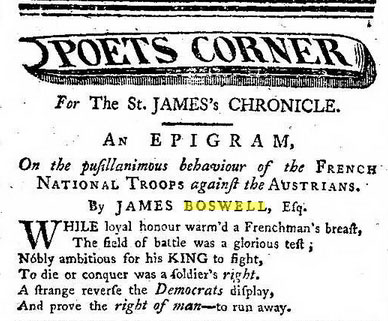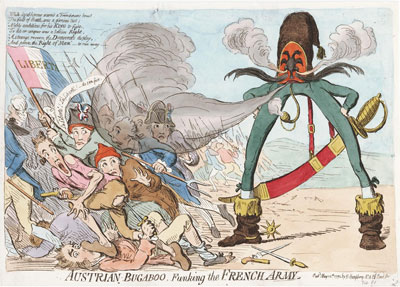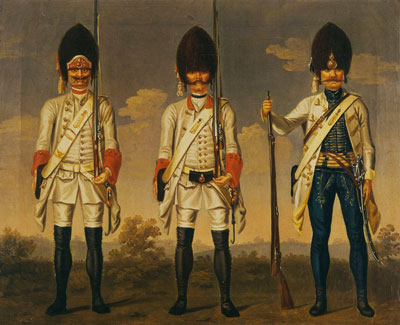Austrian Bugaboo, Funking the French Army
On May 8 1792, readers of London St James Chronicle Or British Evening Post would have seen the following Epigram by the famous biographer of Samuel Johnson. James Boswell. As the title suggests, his witticism was prompted by reports during the previous week in a variety of London newspapers of two routs of French Revolutionary troops by the Austrians—one at Tournai and the other at Mons in Austrian Flanders.

© London St. James Chronicle
Following the lead of some of the newspapers, Boswell had obvious fun in contrasting what he posits to be French courage before and after the Revolution of 1789. Basing his image mostly on the reports out of Mons, Gillray followed suit, appropriating both the words and the tone of the epigram in his Austrian Bugaboo, Funking the French Army.

© Lewis Walpole Library, Yale University
Accounts and troop numbers differ slightly from one source to another*, but it appears that after war was declared against Austria on April 20, 1792, the French army hastily moved troops to strategic locations to prevent an Austrian invasion. Barely trained, ill-equipped, and in some cases suspicious of their French aristocratic commanders, at least some of the revolutionary troops arrived in Lille famished and exhausted. The French Marechal de Rochambeu tried "treacherousiy to gain an advantage" by negotiating a truce with the Austrian commander until May 4th supposedly to allow innocent villagers in the area to get out of harms way. But then on April 28, "to the number of 4000 men, or thereabouts, his troops marched out to attack Tournay."
A copy of a dispatch from M. Chamont, Adjutant-General to Rochambeau (quoted in the Evening Post for May 4, 1792) records the result:
The troops under the command of M. Dillon have been driven back to Lille, after experiencing the most horrible defeat possible to be conceived : one half of the men and horses were killed and disabled on the road, partly through fatigue, and partly by the sword of the Enemy.
But a similar and even more embarrassing scenario played out within the next 24 hours in nearby Mons. Relying once again on the Austrian commander being lulled into a false sense of security by the proposal of a temporary truce, the French "to the number of 9000 . . . marched towards Mons and fired on the town."
Part of the Austrian garrison, consisting all together of only 3600 infantry, and 400 cavalry, sallied out to meet them; and no sooner did they approach and fire, than the whole French army, without firing a second time, or making even a show of resistance, wheeled suddenly about, and took to their heels as fast as their legs could carry them. The cavalry followed their example. The Austrians had not a single man killed or wounded. The French, in their haste to run off, left 500 stand of arms on the ground. The country for some miles was strewed with hats, helmets, and every thing which might accidentally drop off, or impede their flight.
-----
Such are the proofs of that glorious courage with which the ears of the public have so long been stunned by the admirers of this free undisciplined rabble;—such are the effects of that barbarity which is ever the companion of unprincipled Democracy—and such is the first example which the French Reformers have given us of what may be expected from their war with Germany. They began in treachery and ended in cowardice. – Evening Mail, May 04, 1792,Pg. 3,
Gillray beautifully portrays the utter fright and chaos of the scene as the rag-tag revolutionaries drop their makeshift arms and trample upon one another while making their swift retreat. Echoing the Boswell epigram, the French standard bearer, with flag and cockade reminds his cohorts that they are free, that is, free to run away ("La Liberté! La Liberté! - de s'enfuir.")
Using caricature's ability to shape and mis-shape, Gillray creates an Austrian Bugaboo (an imaginary object of fear) out of a grenadier's bearskin hat, the double-headed eagle of the Austrian Habsburgs to create a face, and their characteristic moustache. This bugaboo carries a massive sword, smokes a characteristically Austrian pipe**, and wears jack-boots with enormous spurs, the better to spook or funk his enemies. He has no body, of course, to make the point that he is really nothing, an imaginary compound of the fear of combat and the reputation of Austrian soldiers.

Grenadiers
[~1748]
© Royal Collection Trust
* Varying accounts of the actions can be found in the following newspapers:
- European Magazine And London Review, May 01, 1792,Pg. 90.
- London Lloyd Evening Post, May 04, 1792,Pg. 7.
- Evening Mail, May 04, 1792,Pg. 3.
- London St James Chronicle Or British Evening Post, May 08, 1792,Pg. 4.
- London St James Chronicle Or British Evening Post, May 10, 1792,Pg. 4,
** See Gillray's similar representation of Austria in Allied Powers, Un-Booting Egalitè
Sources and Reading
- Commentary from the British Museum on Austrian Bugaboo, Funking the French Army.
- "James Boswell," Wikipedia
- "War of the First Coalition," Wikipedia
- Thomas Wright and R.H. Evans, Historical and Descriptive Account of the Caricatures of James Gillray #81.
- Thomas Wright and Joseph Grego, The Works of James Gillray, the Caricaturist; With the History of His Life and Times, p. 143.
Comments & Corrections
NOTE: Comments and/or corrections are always appreciated. To make that easier, I have included a form below that you can use. I promise never to share any of the info provided without your express permission.